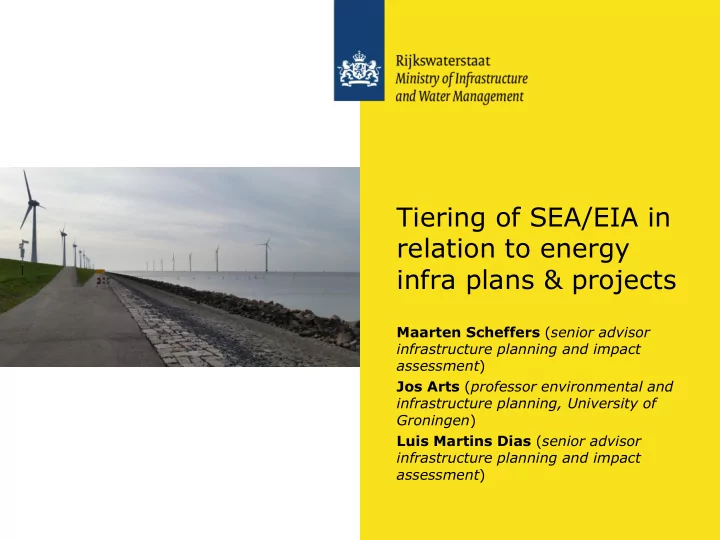

Tiering of SEA/EIA in relation to energy infra plans & projects Maarten Scheffers ( senior advisor infrastructure planning and impact assessment ) Jos Arts ( professor environmental and infrastructure planning, University of Groningen ) Luis Martins Dias ( senior advisor infrastructure planning and impact assessment )
Session outline Introduction of the session (5 min) Introduction to the session theme (15 min) Maarten Scheffers Governance by IA in the Brazilian Hydropower sector (20 min) Prof. Amarilis Gallardo (Escola Politécnica da Universidade de São Paulo (USP) and at Uninove in Brazil) SEA to Mitigate Wildlife Impacts from Wind Power (20 min) Benjamin Skolnik (U.S. government-led Power Africa initiative) German grid development – effects on SEA/EIA (20 min) Dr. Gesa Geissler (Berlin Institute of Technology, Germany) General discussion and conclusions (10 min) Rijkswaterstaat 2
Content Introduction • What is tiering? • Tiering of SEA and EIA • Example of a tiering project in the Netherlands • Discussion and conclusions • Rijkswaterstaat 3
Introduction Focus on energy transition – Paris climate agreement • Need for new infrastructure for renewable energy • Need for space, but also creation of impact on the environment • Different approaches for realization of initiatives are possible (top- • down and bottom-up) Today: focus on (inter)national/regional differences in decision- • making Rijkswaterstaat 4
Questions What is your experience with tiering of plans and projects? How does the national and / or regional context influence the applied approach, the decision-making process and the role of impact assessment? Rijkswaterstaat 5
What is tiering in relation to spatial plans? Tiering is: how the different levels of planning relate to each other. The concept of tiering can be defined as: distinguishing different levels of planning – policy, plans, programs – that are prepared consecutively and influence each other. The theoretical concept of tiering: It is about handing over information to the next level of impact assessment and decision making. Rijkswaterstaat 6
Tiering in relation to SEA and EIA The question is how to deal with the energy transition and achieve the goals in time. Which role plays impact assessment? Are national or regional plans drawn up for energy infrastructure in general or for concrete projects? What is the role of impact assessments at the different levels of decision-making? Can SEA/EIA be the linking pin between them? Two approaches: a “bottom - up” and a “top - down” approach or Rijkswaterstaat 7
I. Bottom-up approach Initiative from local company (profit) or association (non-profit) Smaller contribution to overall sustainable energy goals However, all initiatives are needed as a contribution to the overall goals + Easier participation of surrounding community (or NIMBY ?) - Sub-optimal placing of infrastructure due to lack of potentially good locations - Estimation of environmental impact on broader surrounding area is more difficult (expecting relatively small impact) - Cumulative impacts of different sources in a region is also more difficult to determine Rijkswaterstaat 8
II. Top-down approach Initiative from (central) government Tiering can help to find optimal places for new energy infrastructure Environmental impacts can be assessed on different geographical scales and better related to each other (broad perspective) + Initiatives contribute better to sustainable energy goals due to scale and efficiency (economics of scales) - Procedures might take more procedural and decision time due to ‘not invented here’ syndrome and less public support - Due to technological developments (of i.e. wind turbines) circumstances may change and the environmental impact might need to be re-examined Rijkswaterstaat 9
Example of a top-down approach to wind energy development in the Netherlands - Flevoland In the Netherlands, a top-down approach has been chosen as the most promising approach, which allows areas to be reserved on a national scale and which enables mostly large-scale projects to be realized. However a bottom-up approach is also anticipated in the plans. Rijkswaterstaat 10
The National Policy Strategy for Infrastructure and Spatial Planning (onshore) Most promising areas for inshore wind turbines Rijkswaterstaat 11
National policy strategy for onshore wind energy Potential areas for wind farms Rijkswaterstaat 12
Regional spatial plan for wind energy in Province of Flevoland Specific site selection Rijkswaterstaat 13
Project area in Flevoland province Rijkswaterstaat 14
Tiering of energy PPP in the Netherlands The National Policy Strategy for SEA Infrastructure and A Spatial Planning (2012) National Policy Strategy for Onshore B Wind Energy (2014) Provincial Spatial Plan for Wind C Flevoland (2016) EIA Wind Projects X,Y,Z (2018-2021) Tiering A, B, C Rijkswaterstaat 15
Discussion/conclusions Tiering of environmental info happened! • Project delivery succeeded mostly due to rather good public support in • Flevoland (new polder land) Long time frame: • policy strategy/SEA 2012 project/EIA 2018 realization 2021 Adaptation needed due to: • New info on impacts Changing conditions New concurrent developments (i.e. airport initiative) Rijkswaterstaat 16
Discussion/conclusions The scale of top-down projects is more effective • with respect to the energy goals The best locations were selected: • for large scale energy production with respect to environmental impact with respect to hindrance of the people No discussion anymore within the projects about • location choice The grid connection with the national electricity network is easier • made, when the planning is done at the higher level In the event of changing plans at a lower level, an additional SEA • must be set up, with a good motivation for the change Rijkswaterstaat 17
Thank you! Rijkswaterstaat 18
Recommend
More recommend